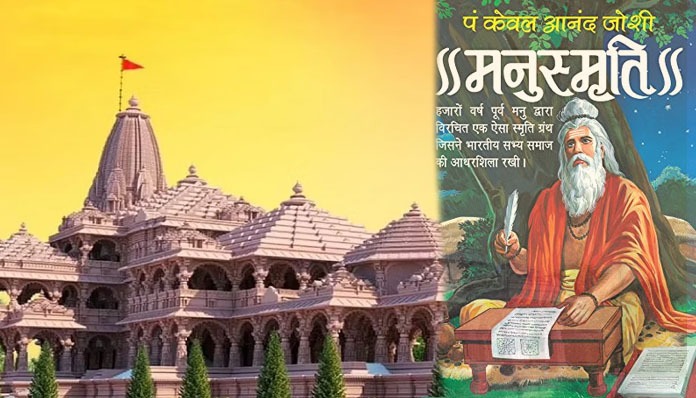MANUSMRITI : The Varna-Based First Sanathana Code of Laws of Dharma – Basic FAQs
Dr.M.Vijaya
– an Academician, Author, Columnist and Social Worker
The oldest known Indus Valley Civilization which spread its settlements in the region known as Bharat, had its first Legal codes known as Manu Smriti. Certain basic details of the ‘Manu Shastra’ are as follows:
- Who is Manu?
Manu is the first human according to Sanathana Dharma. He is regarded as the Father of all Humanity. Manu is considered as the first Law-giver. He was a Jurist who gave individual, domestic and social laws to mankind to run an orderly, ethical society.
- What is Manu Smriti?
Manu Smriti is the first Code of Law created for Humans. It is known as “Manav Dharma Shastra.” It deals with the various aspects of social and moral conduct of a person living in a civilized society.
- How did the Manu Smriti get transmitted?
‘Smriti’ means ‘something carried in memory / remembered.’ Manu’s code of Law is termed as a ‘Smriti’ because –
- Manu Smriti was first given by the Creator – Brahma to Manu;
- Manu transmitted it to the first Guru named Bhrigu;
- Bhrigu passed it on to the Rishis;
- Rishis downloaded it to their Shisyas (disciples); and
- the Codes of Law were thus carried forward generations to generations for several centuries in memory till they were recorded in Palm leaflets and other modes fit enough to be documented.
- Does Manu Smriti talk of Caste?
No. Manu Shastra does not talk of any Caste. Manu Dharma is based on Vedic Guidelines. Vedic Principles of Sanathanam function on the Varna System. Thereby, Manu Smriti also talks of only Varnas and not about Castes.
- What are Castes and Varnas?
According to Sanathana Dharma –
- There are numerous Castes called ‘Jathis’ which evolved over time.
- A person acquires his caste by virtue of birth. That is, the child born to parents of a particular caste gets the caste identity. Caste of a person does not change under any circumstances.
- There are four Varnas which are based on ‘Svabhava’.
- The ‘Svabhava’ or tendency of individual may be –
- Natural tendencies – ‘Guna’ which a person naturally inherits; or
- Mental impressions – ‘Samskaras’ which one acquires from past lives and current experiences
- the occupation of individual.
- The ‘Svabhava’ or tendency of individual may be –
- The ‘Gunas’ (attitudes) are identified as –
- Satvik – calm and composed, contemplative, reflective, scholarly attitude of the individuals;
- Rajas – dynamic, aggressive; and
- Tamas – sluggish, non-thinking, lazy, ignorant.
- The four Varnas based on Gunas are –
- Brahmana Varna – the Satvika Guna is much higher than the Rajas Guna;
- Kshatriya Varna – the Rajas Guna is predominant and the Satva Guna is secondary;
- Vaishya Varna – the Rajas Guna is predominant and the Tamas Guna is secondary;
- Shudra Varna – the Tamas Guna is predominant over the Rajo Guna.
- The 4 Varnas based on Occupation are –
- Brahmana Varna – the intellectual class – Priests, Gurus / Teachers;
- Kshatriya Varna – the warrior class – Administrators, Police;
- Vaishya Varna – Merchant class – Farmers, Business people;
- Shudra Varna – the worker / labourer class – Artisans and Workers.
- Varna is not acquired through birth. Varna is based on the combination of Gunas – thoughts, attitudes and Karma (action / activities) of the individual irrespective of caste.
- People of all Castes can come under any or all the Varnas based on the individual Guna and Karma combinations.
- Sanathanam and Manu Smriti gives equal importance to all castes. Neither Vedas nor Manu Smriti classifies castes under specific varnas. That is, no caste is considered higher or lower than the others.
- The four Varnas can be applied to any society of the world irrespective of caste, ethnicity, race or religion.
- What is the relation between Manu Dharma and the Varnashram?
- Manu Shastra deals with ‘Swadharma’ meaning ‘personal duties.’
- Varna Vyavasta is a hierarchical model based on ‘Gunas’ and ‘Karma’ which facilitates individuals to carry out their ‘Swadharma’ based on their predominant ‘Guna.’
- In simple words, Manu Shastra delineates the ‘personal duties’ of persons under each of the four Varnas.
- The obligations and rights of each Varna are listed in it.
- What are said in Manu Shastra?
Manu Dharma basically contains defined sets of duties, obligations, rights, virtues of good conduct and other essential features for individuals which are the codes required to organize a civilized society and administer based on equality, justice and natural law principles, contributing to a justful, ethical, value-based and disciplined welfare-society.
- Is Manu Smriti applicable in the 21st century modern society of Bharat?
Yes.
Manu Smriti has its roots from the Vedas. Vedas are texts of ‘Eternal Principles.’ Manu Shastra also grounds upon the ‘eternal’ foundation, however, it had been considerably accommodative of additions, revisions, modifications, and deletions of terms effected by needs of time and external influences.
Even today –
- The Hindu Laws are based upon Manu Smriti.
- Several Hindu social rituals, individual thought processes, social orders, etc. are based upon the Manu Dharma.
- Even Courts refer to Manu Dharma for deliverance of Justice in multiple Judgements.
- Did Manu Shastra undergo revisions over time?
Yes. Like how the modern Laws get amended now-and-then, based on needs and the socio-political and cultural changes in the society, over time, minor or major revisions were carried out by Kings and administrators however, keeping intact the essence of the Laws of Dharma.
To sum up, among the several Books of Laws in Bharat, the Manu Smriti is still regarded as the valuable base to determine the dharma – the correct order of righteous and ethical existence which is of a high order.

